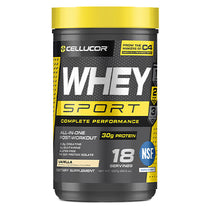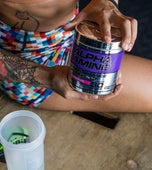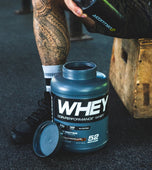
Nowadays, protein powders are everywhere. Once thought of as a supplement for bodybuilders looking to bulk up, protein powders are a staple in many people’s pantries. It’s easy to understand why protein is a vital macronutrient; besides helping us build muscle mass, protein plays a crucial role in helping us maintain healthy organs, bones, and hair.
In this article, we'll cover the different types of protein powders on the market. After reading this, you’ll understand some of the most common protein sources, their processing methods, and key features to identify in powders to help you select the right one to suit your needs.
Types of Protein Powders

Before getting into the familiar protein sources, let’s go over how these different protein sources are processed. The various processing methods used for proteins are done primarily to impact their macronutrient/caloric content and their rate of digestion. Some proteins are processed more to filter out carbohydrates and fats, resulting in a powder that yields a higher percentage of protein per serving. While others are minimally processed and have macronutrient ratios closer to the whole food sources they’re derived from.
Whey Concentrate
Whey is a minimally processed form of protein powder. A protein concentrate will generally contain 30-80% protein by weight. The remaining content in these powders comprises other macronutrients like carbohydrates and fats. Protein concentrates typically have the highest caloric content of the different powder types because they contain more fat and carbohydrates (especially sugar).
Whey Isolate
Isolate is a more processed form of protein powder. A protein isolate will generally contain 90-95% protein by weight, with the remaining amount being fat and carbohydrates. Isolate protein powders typically have fewer calories than concentrates.
Hydrolysate
Hydrolysate is an ultra-processed form of protein powder. The protein source is hydrolyzed (a chemical reaction where a water molecule breaks a chemical bond) into peptides and amino acids to make this powder. Hydrolyzed proteins have minimal amounts of carbohydrates and fat. They’re the fastest digesting form of protein powders and commonly the most expensive.

Common Protein Powder Sources
Whey Protein Powder
Whey Protein is a dairy protein that makes up about 20% of the protein in cow’s milk. It’s considered a high-quality protein source because it’s very bioavailable and rich in essential amino acids. Whey is a fast-digesting protein; because of this, it’s often used immediately after workouts.
Casein Protein Powder
Casein Protein a type of dairy protein that makes up about 80% of the protein in cow’s milk. It’s considered a high-quality protein source because it’s very bioavailable and contains all the essential amino acids. Casein is a slow-digesting protein; because of this, it’s commonly used before bedtime.
Milk Protein Powder
Milk Protein is a dairy protein made up of a blend of whey and casein. Milk protein is a complete protein because it contains all essential and non-essential amino acids. Milk protein powder is available as both a concentrate and an isolate.
Collagen Protein Powder
Collagen Protein is a protein that makes up the connective tissue of animals like their cartilage, bones, tendons, and skin. Collagen protein powders are typically derived from bovine or marine sources. Collagen is an incomplete protein because it doesn’t contain all nine of the essential amino acids.
Egg Protein Powder
Egg protein powder is derived from egg whites. It’s considered a high-quality protein source because it’s a complete protein with high bioavailability. Egg isolate powder is a medium-digesting protein.
Soy Protein Powder
Soy protein is a plant-based protein derived from soybean legumes. Soy protein powder is unique among plant-based protein sources because it’s a complete protein. It contains all nine essential amino acids. Soy is a medium-digesting protein.
Pea Protein Powder
Pea Protein is also a plant-based protein obtained from yellow and green split peas. Pea protein contains all nine essential amino acids; however, the content of the amino acids methionine and cysteine is inadequate amounts to consider it a complete protein. Pea is a medium-digesting protein.
Rice Protein Powder
Rice Protein is a plant-based protein. Rice protein contains all nine essential amino acids; howe, the amino acid lysine content is inadequate to consider it a complete protein. Rice is a medium-digesting protein.
Hemp Protein Powder
Hemp protein is a plant-based protein derived from the cannabis plant (no worries, it’s free of the psychoactive substances that would get you high). It contains essential amino acids; however, its lysine content is inadequate to consider it a complete protein. Hemp protein powders also often contain essential fatty acids and fiber.
Protein Blends
Protein blends are combinations of different protein sources. Some of the most common blends are seen in dairy-based protein powders, where a variety of whey, milk, and casein are all used in the same powder, and in plant-based powders with different plant-based sources like pea and rice protein powders are combined. Protein blends are commonly used to impact the absorption rate and provide a broader range of amino acids.
With dairy-based powders, whey and casein are often combined to provide fast and slow-digesting proteins. While in plant-based powders, these blends are usually done so that the different protein sources can complement each other to form a complete protein source.
Protein blends are sometimes used to manage the costs of a protein powder because some protein sources are more expensive than others. And finally, because the different protein sources have different flavors and textures, blends can be done to impact the overall taste experience of a powder.

What to Look for in a Protein Powder
Now that we have covered the different processing methods for protein powders and some of the most common sources, let’s cover the necessary items to look at when comparing powders.

Determining Your Protein Source
The protein source of your powder is essential for several reasons. For instance, if you’re following a specific diet, like a vegetarian diet, you’d naturally want to avoid powders derived from animal sources. Similarly, if you’re looking for features like a fast or slow digestion rate, you’d like a protein source that meets your needs.
Dosage & Servings Per Container
The dosage per scoop and servings per container in your protein powder are significant numbers. These two numbers can help you better compare the prices of the powders you’re considering. And you can figure out the cost per serving of the different powders.
For example, product A gives you 20 scoops of 25 grams of protein for $45. At the same time, product B gives you 15 scoops of 25 grams of protein 25 grams of protein for $37. The cost per serving of product A is ($45/20) = $2.25, while the cost per serving of product B is ($37/15) = $2.46. In this example, product B has a lower price per serving.
Additional Ingredients
Additional protein powder ingredients can include macronutrients like fat and carbohydrates. As well as other ingredients like natural or artificial flavors, sweeteners, and colors. Knowing the amounts of the different macronutrients in your protein powder can help you monitor your caloric intake and evaluate which powders are a good option for your dietary needs. Similarly, if you prefer to avoid artificial flavors or sweeteners, looking for these items on a product label can help you decide when shopping.
% Of Protein per Scoop
The protein per scoop is the amount relative to the additional ingredients in a single serving. You can figure this number out by reading the product label, seeing what protein dosage per scoop is used in the product, and comparing it to the overall scoop size of a single serving. This number helps evaluate how much protein you’re getting in your product relative to other ingredients. Some products may contain additional ingredients like carbohydrates, fats, sweeteners, and artificial flavors, while others may have minimal amounts. For example, product A has 25 g of protein and a 32 g scoop size, while product B also has 25 g of protein but a 40 g scoop size. This would mean that protein is (25/32) 78% of the material inside a scoop of product A while only making up 63% (25/40) of the material inside a scoop of product B.
Third-Party Certifications
Third-Party Certifications on protein powders are obtained when companies voluntarily submit their products to be tested by other organizations so that they can be evaluated relative to the standards of these third parties. Third-party certifications can inform consumers if a product has been tested for banned substances, contains organic contents, or meets critical control processing standards. These certifications are essential for people that need their product to meet specific standards because of religious, professional, or personal reasons.
Meet Your New Protein Powder!
Featuring 25g of Whey Isolate and 7g total BCAAs per serving, XTEND Pro takes muscle repair and recovery to the next level. With delicious gluten-free flavors and two third-party certifications, it's no wonder that XTEND Pro is the protein choice of champions!





















